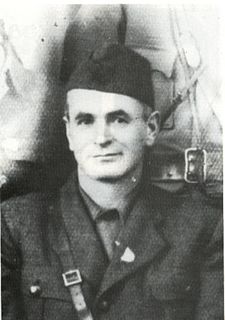History
After the Bulgarian takeover of Vardarska Banovina in April 1941, the Macedonian communists fell in the sphere of influence of the Bulgarian Communist Party. [7] They thought that the ordinary Macedonian people believe in Bulgaria's role as liberator and that no Macedonian wants to fight against the Bulgarian soldiers. [8] Nevertheless when the USSR was attacked by Nazi Germany in June, some form of anti-Axis resistance started, with the emergence of Macedonian Partisan military units. Initially they had no real success, starting to grow only in 1943 with the capitulation of Italy and the Soviet victories over Nazi Germany. [9] [10] The role of the Bulgarian communists, which avoided organizing mass armed resistance in the area, was also a key factor. [11] Although several Macedonian partisan detachments were formed through the end of 1942 which fought battles against the Bulgarian, Italian, German and Albanian occupation forces and despite Sofia's ill-managed administration, most Macedonian Communists had yet to be lured to Yugoslavia. Between 1941 and 1943, Tito have sent five emissaries to Macedonia, to persuade his ill-disciplined comrades, but their efforts had limited success, and the Regional Committee of the Communists in Macedonia was de facto under the control of the Bulgarian Communist Party. [12]
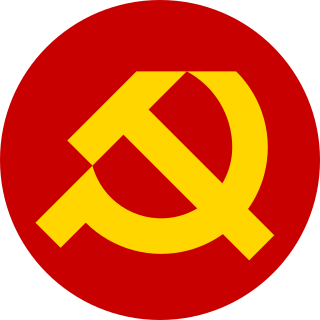
The Bulgarian Communist Party was the Communist and Marxist-Leninist ruling party of the People's Republic of Bulgaria from 1946 until 1989 when the country ceased to be a socialist state. The Bulgarian Communist Party had dominated the Fatherland Front coalition that took power in 1944, late in World War II, after it led a coup against Bulgaria's tsarist regime in conjunction with the Red Army's crossing the border. It controlled its armed forces, the Bulgarian People's Army.

Nazi Germany is the common English name for Germany between 1933 and 1945, when Adolf Hitler and his Nazi Party (NSDAP) controlled the country through a dictatorship. Under Hitler's rule, Germany was transformed into a totalitarian state where nearly all aspects of life were controlled by the government. The official name of the state was Deutsches Reich until 1943 and Großdeutsches Reich from 1943 to 1945. Nazi Germany is also known as the Third Reich, meaning "Third Realm" or "Third Empire", the first two being the Holy Roman Empire (800–1806) and the German Empire (1871–1918). The Nazi regime ended after the Allies defeated Germany in May 1945, ending World War II in Europe.

Josip Broz, commonly known as Tito, was a Yugoslav communist revolutionary and statesman, serving in various roles from 1943 until his death in 1980. During World War II, he was the leader of the Partisans, often regarded as the most effective resistance movement in occupied Europe. While his presidency has been criticized as authoritarian and concerns about the repression of political opponents have been raised, most Yugoslavs considered him popular and a benevolent dictator.
To change that, in the beginning of 1943 the Montenegrin Svetozar Vukmanović-Tempo was sent by Tito as an assistant to the HQ of the Macedonian partisan forces. He was supposed to set up a Macedonian Communist Party within the framework of the Yugoslav one. One of his objectives was to destroy the influence of the BCP in Macedonia and to fight against any form of Macedonian autonomism. He would have to "Macedonize" the struggle’s form and content, and to give it an ethnic Macedonian facade. One of his main achievements was also that the wartime pro-Bulgarian trend receded into the background of pro-Yugoslav one. Tempo was able to capitalize on the growing contradictions towards Bulgarian authorities, which during 1942 were involved into a policy of centralization, contradicting their initial agenda to respect Macedonian autonomy. Yugoslav communists proclaimed as their aim the issue of unification of the three regions of Macedonia – Yugoslav, Greek and Bulgarian, and so managed to get also Macedonian nationalists. As result the Communist Party of Macedonia (CPM) was formed on 19 March 1943 in Tetovo.

Yugoslavism or Yugoslavdom refers to the unionism, nationalism or patriotism associated with South Slavs/Yugoslavs and Yugoslavia. Yugoslavism has historically advocated the union of all South Slav populated territories now composing Bosnia and Herzegovina, Croatia, Montenegro, Serbia, Slovenia, North Macedonia, and, for some like Ivan Meštrović, Bulgaria. It became a potent political force during World War I with the assassination of Archduke Franz Ferdinand of Austria by the Yugoslavist militant Gavrilo Princip and the subsequent invasion of Serbia by Austria-Hungary. During the war the Yugoslav Committee composed of South Slav emigres from Austria-Hungary, supported Serbia and vouched for the creation of a Yugoslav state. On 1 December 1918, King Peter of Serbia proclaimed the Kingdom of Serbs, Croats, and Slovenes, commonly known as "Yugoslavia". During the Yugoslav period, a Yugoslav identity was propagated.
The date of the creation of its major unit, the Mirče Acev Battalion, on August 18, 1943 on Mount Slavej [13] between Ohrid and Kičevo, is officially celebrated today in North Macedonia as the Day of the Army of the Republic of North Macedonia. On 11 November 1943, the 1st Macedonian Kosovo Shock Brigade was formed in western Macedonia by merging two Vardar Macedonian and one Kosovo battalion. The second — larger ethnic Macedonian military unit was the 2nd Macedonian Shock Brigade, formed on 22 December 1943 just across the border in Greek Macedonia. [14] On 26 February 1944 in the village of Zegljane, near Kumanovo, the 3rd Macedonian Shock Brigade was formed. These three brigades were the nucleus of the National Liberation Army of Macedonia, which after constant battles became stronger in numbers. From 7,000 partisans in the late 1943, until the final military operations in the Yugoslav National Liberation War in April 1945, the National Liberation Army of Macedonia had increased to three Corps, seven divisions and thirty brigades, all with a total of 100,000 regular soldiers. [15]

A battalion is a military unit. The use of the term "battalion" varies by nationality and branch of service. Typically a battalion consists of 300 to 800 soldiers and is divided into a number of companies. A battalion is typically commanded by a lieutenant colonel. In some countries, the word "battalion" is associated with the infantry.

Ohrid is a city in North Macedonia, the seat of Ohrid Municipality. It is the largest city on Lake Ohrid and the eighth-largest city in the country, with over 42,000 inhabitants as of 2002. Ohrid once had 365 churches, one for each day of the year, and has been referred to as a "Jerusalem of the Balkans". The city is rich in picturesque houses and monuments, and tourism is predominant. It is located southwest of Skopje, west of Resen and Bitola. In 1979 and in 1980 respectively, Ohrid and Lake Ohrid were accepted as Cultural and Natural World Heritage Sites by UNESCO. Ohrid is one of only 28 sites that are part of UNESCO's World Heritage that are Cultural as well as Natural sites.

Kičevo is a city in the western part of the Republic of North Macedonia, located in a valley in the south-eastern slopes of Mount Bistra, between the cities of Ohrid and Gostivar. The capital Skopje is 112 km away. The city of Kičevo is the seat of Kičevo Municipality.

The Yugoslav Partisans, or the National Liberation Army, officially the National Liberation Army and Partisan Detachments of Yugoslavia, was the Communist-led resistance to the Axis powers in occupied Yugoslavia during World War II.

The Socialist Republic of Macedonia was one of the six constituent countries of the Socialist Federal Republic of Yugoslavia, and a socialist nation state of the Macedonians. After the transition of the political system to parliamentary democracy in 1990, the Republic changed its official name to Republic of Macedonia in 1991, and with the beginning of the breakup of Yugoslavia, it declared itself an independent country on 8 September 1991.
The Anti-fascist Assembly for the National Liberation of Macedonia was the supreme legislative and executive people's representative body of the Macedonian state from 1944 until the end of World War II. The body was set up by the Macedonian Partisans during the final stages of the National Liberation War of Macedonia in the summer of 1944, in the Bulgarian occupation zone of Yugoslavia.

Military operations in World War II in Yugoslavia began on 6 April 1941, when the Kingdom of Yugoslavia was swiftly conquered by Axis forces and partitioned between Germany, Italy, Hungary, Bulgaria and client regimes. Subsequently, a guerrilla liberation war was fought against the Axis occupying forces and their locally established puppet regimes, including the fascist Independent State of Croatia and the Government of National Salvation in the German-occupied territory of Serbia, by the Communist-led republican Yugoslav Partisans. Simultaneously, a multi-side civil war was waged between the Yugoslav communist Partisans, the Serbian royalist Chetniks, the Croatian fascist Ustashe and Home Guard, Serbian Volunteer Corps and State Guard, as well as Slovene Home Guard troops.
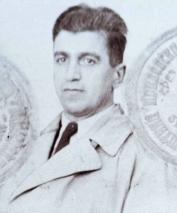
Metodi Tasev Shatorov - Sharlo was a Bulgarian communist leader during the first half of 20th century and also temporary leader of the Vardar Macedonian communists in 1940-1941. As most left-wing politicians from Macedonia, during the 1930s he adopted the Balkan Communist Federation's concept for an autonomous Macedonia. However, Macedonian communist functionaries, originating from the Bulgarian Communist Party (BCP) and Internal Macedonian Revolutionary Organization (United) never lost their strong pro-Bulgarian (Bulgarophile) sentiments.

Mihajlo Apostolski was a Yugoslav general, military theoretician, politician and historian. He was commander of the Headquarters of the National Liberation Army and Partisan detachments of Macedonia, colonel general of the Yugoslav National Army (JNA), and was declared a People's Hero of Yugoslavia.
The National Liberation Front, also known as the People's Liberation Front, was a communist political and military organization created by the Slavic Macedonian minority in Greece. The organization operated from 1945–1949, most prominently in the Greek Civil War. As far as its ruling cadres were concerned its participation in the Greek Civil War was nationalist rather than communist, with the goal of secession from Greece.
Ohrana were armed collaborationist detachments organized by the former Internal Macedonian Revolutionary Organization (IMRO) structures, composed of Bulgarians in Nazi-occupied Greek Macedonia during World War II and led by officers of the Bulgarian Army. Bulgaria was interested in acquiring Thessalonica and Western Macedonia, under Italian and German occupation and hoped to sway the allegiance of the 80,000 Slavs who lived there at the time. The appearance of Greek partisans in those areas persuaded the Axis to allow the formation of these collaborationst detachments. However, during late 1944, when the Axis appeared to be losing the war, many Slavophone Nazi collaborators, Ohrana members and VMRO regiment volunteers fled to the opposite camp by joining the newly founded communist SNOF. The organization managed to recruit initially 1,000 up to 3,000 armed men from the Slavophone community that lived in the western part of Greek Macedonia.

World War II in Yugoslav Macedonia started with the Axis occupation of Yugoslavia. Macedonian communist Partisans of the People's Liberation Army of Macedonia, part of the Yugoslav Partisan movement, started a political and military campaign on 11 October 1941 to resist the occupation of Vardar Macedonia by Bulgarian, German, Italian, and Albanian forces. Officially, the area was called then Vardar Banovina, because the very name Macedonia was prohibited in the Kingdom of Yugoslavia.
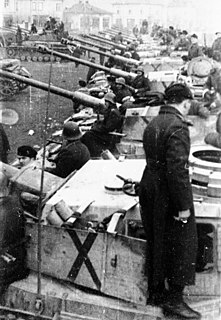
The Kosovo Operation was a series of military operations leading up to one final push during World War II, launched by the Bulgarian army with the assistance of Yugoslav and Albanian Partisans to expel German forces from Kosovo and prevent the retreat of German forces from Greece. German Army Group E was withdrawing through it from Greece towards Bosnia, since the escape route through Niš and Belgrade had been closed by the Yugoslav Partisan, Bulgarian and Soviet forces.

The Belgrade Offensive or the Belgrade Strategic Offensive Operation was a military operation in which Belgrade was liberated from the German Wehrmacht through the joint efforts of the Soviet Red Army, Yugoslav Partisans, and the Bulgarian People's Army. Soviet forces and local militias launched separate but loosely cooperative operations that undermined German control of Belgrade and ultimately forced a retreat. Martial planning was coordinated evenly among command leaders, and the operation was largely enabled through tactical cooperation between Josip Broz Tito and Joseph Stalin that began in September 1944. These martial provisions allowed Bulgarian forces to engage in operations throughout Yugoslav territory, which furthered tactical success while increasing diplomatic friction.

In September 1944, Nazi Germany briefly sought to establish an Independent State of Macedonia, a puppet state in the territory of the Kingdom of Yugoslavia that had been occupied by the Kingdom of Bulgaria following the invasion of Yugoslavia in April 1941. When Soviet Union forces approached the borders of Bulgaria near the end of August 1944, Bulgaria declared neutrality and briefly sought to negotiate with the Western Allies. As the Bulgarian government was not impeding the withdrawal of German forces from Bulgaria or Romania, the Soviet Union treated it with suspicion. On 2 September a new pro-Western government took power in Sofia, only to be replaced a week later by a pro-communist government after a Fatherland Front–led revolt. However, on 5 September 1944, the Soviets declared war on Bulgaria.
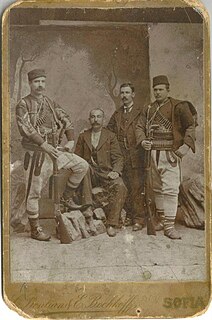
Mirche Atsev, or Mirče Acev, nicknamed Orovchanets, was a Bulgarian revolutionary from Ottoman Macedonia, a leader of an Internal Macedonian-Adrianople Revolutionary Organization (IMARO) revolutionary band. In the Republic of Macedonia he is considered Ethnic Macedonian.
The Partisan 9th Corps, was a formation of the Yugoslav Partisans during World War II. It consisted of division and brigade-size units, and operated in the Italian-annexed Province of Ljubljana, in Yugoslav territories under German civil administration, the Independent State of Croatia and northeastern Italy during World War II.
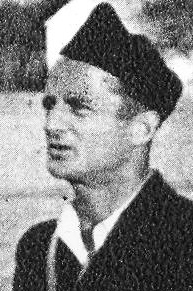
Vicko Krstulović was a Croatian Yugoslav revolutionary, military commander and politician from Dalmatia. He was an illegal communist activist during the 1920s and 1930s in Split at a time when communist sympatizers were brutally persecuted by the Yugoslav monarchy. As an officer in the Yugoslav Partisans during World War II, he was in charge of creating and organising the resistance movement in Dalmatia. In Socialist Yugoslavia, he worked in various government offices and was remembered for his work and contribution to his native Split.

The Vardar Corps was a corps of the Yugoslav Army in the Homeland (JVuO) that operated on the left bank of the river Vardar during the World War II in Yugoslavia on the territory of modern-day North Macedonia and southern Serbia. Its commander was former Captain of the Royal Guard of the Royal Yugoslav Army Stojan Krstić. It consisted of four brigades with total number of 1,000 soldiers. Together with Jablanica Corps, South Morava Corps and Flying Corps it belonged under Mountain Staff 110 located in Sijarinska Banja which was responsible for the territory of Southern Serbia. The four brigades that were components of this Corps were:

Haim Estreya Ovadya was a Macedonian Jewish communist who joined the Yugoslav Partisans after the German invasion of Yugoslavia in 1941 during World War II.
The day of the Macedonian Uprising in 1941 is October 11. It marks the anniversary of the beginning of the Macedonian uprising against fascism during World War II in Yugoslav Macedonia. Since the times of SFRY this was the national holiday in SR Macedonia and later in Republic of Macedonia it was proclaimed a public holiday. It is a non-working day.
The Regional Committee of the Communists in Macedonia was the provincial communist organization in Vardar Macedonia from 1939 to 1943.











